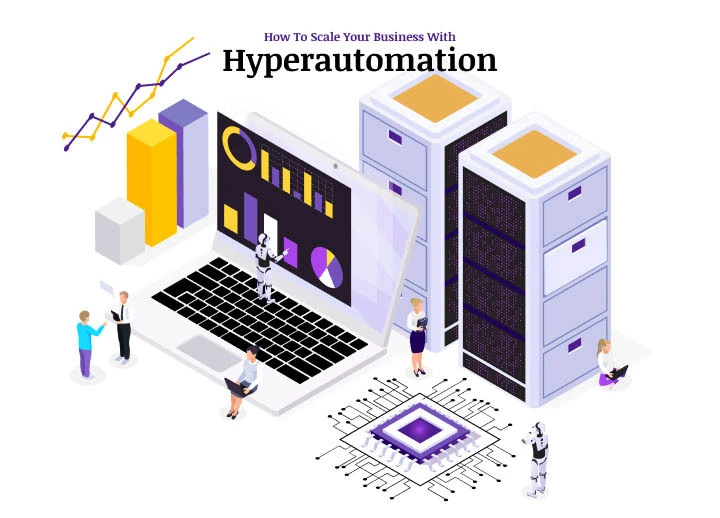Since technology is developing rapidly, businesses of every size need to streamline their processes to reduce costs, increase productivity, and increase revenue. This is possible only with AI-based automation.
IDC forecasts that the economic impact of AI-powered automation across all the lines of business and IT functions will be USD 20 trillion by the end of 2025.
But, the issue with current automation processes is their inflexibility. These processes are limited to simple tasks and often fail to automate end-to-end processes.
That’s where hyper-automation trends contribute to digital transformation. Here, we will discuss hyper-automation use cases that organizations can use to successfully streamline and scale their business operations.

HyperAutomation Vs. Automation: What’s The Difference?
First, let’s understand what is automation. RPA (Robotics Process Automation) is the automation of repetitive, complex processes using trained robots.
But, as always, automation can be pretty inflexible. The automation tools are rule-based or script-based. As a result, many of them can only automate simple tasks on an ad hoc basis.
The problem with automation tools is that organizations cannot easily integrate other processes and often have to rely on a patchwork of tools full of loopholes. Hence, it becomes difficult for IT organizations to automate end-to-end processes and support business initiatives.
That’s where hyper-automation steps in.
According to Gartner, “hyper-automation utilizes advanced technologies such as artificial intelligence (AI) and machine learning (ML) to augment people and automate processes.”
In other words, hyper-automation takes automation to an advanced level where organizations can automate as many tasks as possible to make way for digital transformation. This opens up a lot more possibilities.
Benefits of HyperAutomation
- Reduce the costs of automation.
- Aligns business and IT better.
- Enhances AI integration with the business.
- Enhances the measurement of the impact of digital transformation.
- Aids in the development of future automation processes.
How to Use Hyperautomation To Scale Your Business Operation?
By reducing human intervention, organizations can scale rapidly. Learn how hyper-automation tools boost the efficiency of your organization.
1. Accelerate And Automate Complex Processes
Hyper automation eliminates complex labor that relies on human knowledge input, allowing every workforce member to participate in company growth.
Embracing hyper-automation is essential for digital transformation. Marrying the correct strategic tool with virtual reality automates the automation and takes your business to the next level. This is the essence of true digital transformation.
Making use of robotic process automation (RPA), machine learning (ML), and artificial intelligence (AI) in conjunction with each other to automate business processes handled by specialists in the past.
2. Use Advanced Analytics For Actionable Insights
Robotic Process Automation is restricted to structured data when it comes to analytics. However, you can analyze both structured and unstructured data using complex analytical tools with Hyper Automation technologies.
Businesses can access previously unavailable data and use it for analysis, which allows them to get critical actionable insights. By assessing and demonstrating automation ROI and its influence on specific business objectives, advanced analytics can also aid companies in achieving their business objectives.
To improve ROI, one needs to analyze data utilization and tools to better understand processes, predictions, and results.
3. Business Process Management
A critical component of hyper-automation is the management of business processes (BPM).
A successful automation plan is built on this groundwork and can be constructed, monitored, and improved in many ways. However, it can be difficult for companies without an automated workflow to integrate new digital technologies.
Organizations need to develop new procedures and test them before implementing them to prevent malfunctions that might severely disrupt their operations.
Managing an organization’s hyper-automation strategy and projects is easier when using hyper-automation tools like business process management software.
An effective automation strategy relies on BPM as its cornerstone, as it serves as a foundation to plan, build, monitor, and enhance automated processes.
4. Deploy Digital Workforce
An intelligent digital workforce is formed when combined cognitive intelligence, robotics, and automation. Automation of monotonous operations and improving employee performance are possible with this combination.
A digital worker is an agent of transformation in a hyper-automated workplace. These digital workers connect multiple business systems, work with various data formats, analyze the data to make intelligent decisions, and discover new automation opportunities.
By implementing a digital workforce, everyone is empowered personally and professionally. In addition, automation makes it possible to automate and contribute to the organization’s transformation.
Conclusion
Hyper-automation tools automate almost every aspect of a business, as shown above. When organizations can automate as many tasks as possible, developing reliable end-to-end processes that support new business initiatives becomes more accessible. As a result, your costs decrease, your workforce is managed, and your revenue grows.
Is your organization ready for Hyperautomation yet?